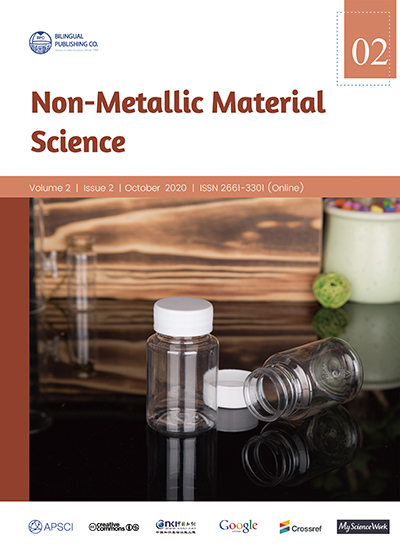-
921
-
917
-
876
-
509
-
393
A Potential Approach to Enhance the Seebeck Coefficient of UHMWPE by Using the Graphene Oxide
DOI:
https://doi.org/10.30564/omms.v2i2.2601Abstract
Thermoelectric materials have been a competent source for the production of energy in the present decade. The most important and potential parameter required for the material to have better thermoelectric characteristics is the Seebeck coefficient. In this work, ultra high molecular weight polyethylene (UHMWPE) and graphene oxide (GO) nanocomposites were prepared by mechanical mixing by containing 10000ppm, 50000ppm, 70000ppm, 100000ppm, 150000ppm, and 200000ppm loadings of graphene oxide. Due to the intrinsic insulating nature of UHMWPE, the value of Seebeck for pristine UHMWPE and its nanocomposites with 10000ppm & 50000ppm of GO concentration was too low to be detected. However, the Seebeck coefficient for composites with 70000ppm, 100000ppm, 150000ppm, and 200000ppm loadings of GO was found to be 180, 206, 230, and 235 µV/ K, respectively. These higher values of Seebeck coefficients were attributed to the superior thermal insulating nature of UHMWPE and the conductive network induced by the GO within the UHMWPE insulating matrix. Although, the values of the figure of merit and power factor were negligibly small due to the lower concentration of charge carriers in UHMWPE/ GO nanocomposites but still reported, results are extremely hopeful for considering the composite as the potential candidate for thermoelectric applications.Keywords:
UHMWPE, Graphene oxide, Electrical conductivity, Thermal conductivity, Seebeck coefficient, Figure of meritReferences
[1] G. J. Snyder, E. S. Toberer. Complex thermoelectric materials. In Materials for sustainable energy: a collection of peer-reviewed research and review articles from Nature Publishing Group, ed: World Scientific, 2011: 101-110.
[2] G. Mahan. Introduction to thermoelectrics. APL Materials, 2016, 4: 104806.
[3] Y. Zhu, S. Murali, W. Cai, X. Li, J. W. Suk, J. R. Potts, et al. Graphene and graphene oxide: synthesis, properties, and applications. Advanced materials, 2010, 22: 3906-3924.
[4] Y. Du, S. Z. Shen, W. Yang, R. Donelson, K. Cai, P. S. Casey. Simultaneous increase in conductivity and Seebeck coefficient in a polyaniline/graphene nanosheets thermoelectric nanocomposite. Synthetic Metals, 2012, 161: 2688-2692.
[5] J. Xiang, L. T. Drzal. Templated growth of polyaniline on exfoliated graphene nanoplatelets (GNP) and its thermoelectric properties. Polymer, 2012, 53: 4202-4210.
[6] D. Yoo, J. Kim, S. H. Lee, W. Cho, H. H. Choi, F. S. Kim, et al. Effects of one-and two-dimensional carbon hybridization of PEDOT: PSS on the power factor of polymer thermoelectric energy conversion devices. Journal of Materials Chemistry A, 2015, 3: 6526-6533.
[7] J. Xiong, F. Jiang, H. Shi, J. Xu, C. Liu, W. Zhou, et al. Liquid exfoliated graphene as dopant for improving the thermoelectric power factor of conductive PEDOT: PSS nanofilm with hydrazine treatment. ACS Applied Materials & Interfaces, 2015, 7: 14917- 14925.
[8] A. Gao, F. Zhao, F. Wang, G. Zhang, S. Zhao, J. Cui, et al. Highly conductive and light-weight acrylonitrile-butadiene-styrene copolymer/reduced graphene nanocomposites with segregated conductive structure. Composites Part A: Applied Science and Manufacturing, 2019, 122: 1-7.
[9] S. A. Maqbool, M. S. Mehmood, S. S. Mukhtar, M. A. Baluch, S. Khan, T. Yasin, et al. Dielectric relaxation and acconduction in γ-irradiated UHMWPE/ MWCNTs nano composites: impedance spectroscopy analysis. Radiation Physics and Chemistry, 2017, 134: 40-46.
[10] M. S. Mehmood. Characterization of gamma sterilized and cross-linked vitamin-E stabilized ultra-high molecular weight polyethylene. Pakistan Institute of Engineering & Applied Sciences, Islamabad., 2013.
[11] M. S. Mehmood, M. S. Jahan, T. Yasin, M. Tariq, M. A. Choudhry, M. Ikram. On the structural analysis of [gamma]-ray induced primary free radicals in UHMWPE and vitamin E stabilized UHMWPE by ESR spectroscopy. Journal of Spectroscopy, 2015, 2015.
[12] M. S. Mehmood, T. Yasin, M. S. Jahan, S. R. Mishra, B. M. Walters, M. Ahmad, et al. Assessment of residual radicals in γ-sterilized shelf-aged UHMWPE stabilized with α-tocopherol. Polymer degradation and stability, 2013, 98: 1256-1263.
[13] M. S. Mehmood, B. M. Walters, T. Yasin, M. Ahmad, M. S. Jahan, S. R. Mishra, et al. Correlation of residual radical’s with three phase morphology of UHMWPE: Analysis for the dependence on heat involved during vitamin E diffusion. European polymer journal, 2014, 53: 13-21.
[14] H. Bahrami, A. Ramazani SA, A. Kheradmand, M. Shafiee, H. Baniasadi. Investigation of thermomechanical properties of UHMWPE/graphene oxide nanocomposites prepared by in situ Ziegler–Natta polymerization. Advances in Polymer Technology, 2015, 34.




 Aqsa Irfan
Aqsa Irfan





